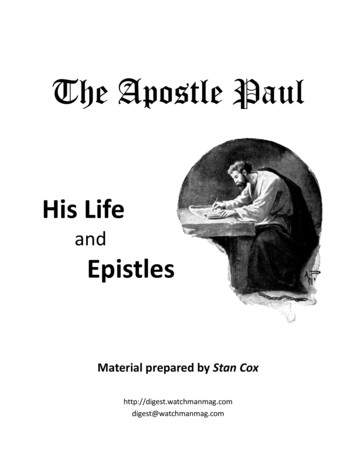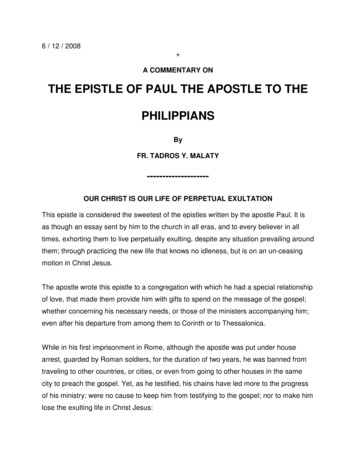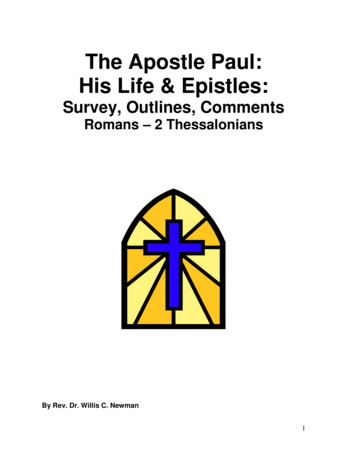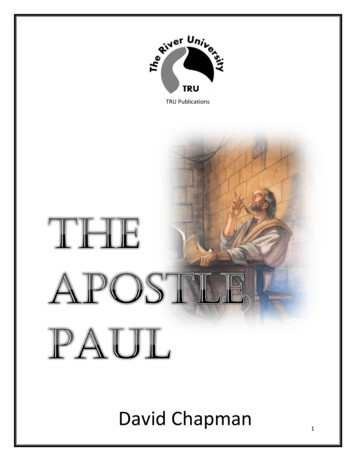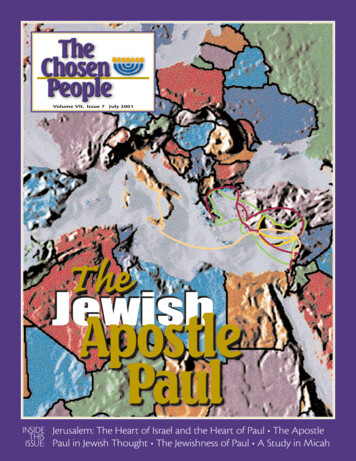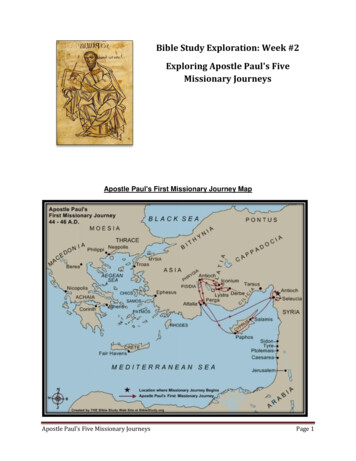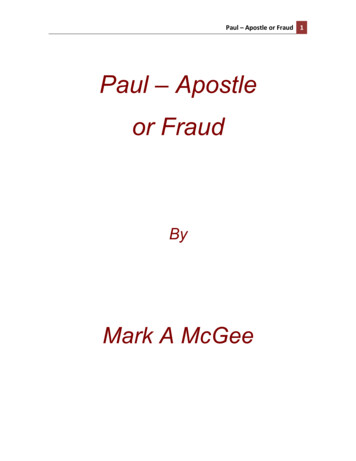
Transcription
Part 4The Apostle Paul, GeneralEpistles, and Revelation
23The Life of the Apostle PaulAn OverviewNicholas J. Frederick“Few figures in Western history have been the subject of greater controversy than Saint Paul.Few have caused more dissension and hatred. None has suffered more misunderstanding atthe hands of both friends and enemies. None has produced more animosity between Jews andChristians.”1These words, taken from a recent study of Paul by emeritus Princeton University professor John G. Gager, speak to the impact Paul has had in the roughly two thousand yearssince the emergence of the Christian faith. Paul continues to be the topic of much debate inthe modern era, with books describing Paul as everything from the “real founder of Christianity”2 to a “Jewish cultural critic.”3 While it may be close to impossible to retrieve thehistorical Paul from the pages of the New Testament, this chapter will attempt to construct abrief biographi cal overview of Paul and his life, synthesizing information from the book ofActs and from Paul’s own letters while also remaining cognizant that there are several placeswhere the New Testament sources are reticent or in disagreement.The Early Life of PaulThe majority of Paul’s life prior to his shift toward Christianity remains shrouded in mysteryand must be reconstructed from the small glimpses given us through Paul’s letters and Luke’s
394Nicholas J. Frederickhistory. One of the most important statements comes from Paul’s letter to the Philippians,where he writes:Circumcised the eighth day, of the stock of Israel, of the tribe of Benjamin, an Hebrew of the Hebrews; as touching the law, a Pharisee; Concerning zeal, persecuting thechurch; touching the righteousness which is in the law, blameless. (Philippians 3:5–6)While these may seem like small details, they are actually quite revealing. Paul’s wordssuggest that religiously and ethnically he saw himself as a Jew. His descent through the tribeof Benjamin likely explains the origin of his actual name, Saul. While it is sometimes thoughtthat Saul was Paul’s name prior to becoming a Christian and that he took the name Paul afterhe became Christian, this is incorrect. Saul is a Hebrew name, and Paul a Roman name. Themost notable member of the tribe of Benjamin was King Saul, the ruler who preceded David.While Saul is remembered somewhat negatively today, mainly owing to his improper offering of sacrifice and his acrimony toward David, he remained an important figure in Israelitehistory, and it is not surprising that Paul’s Jewish parents would pass on that name to him.On the other hand, Paul means “short” or “small” in Latin and is a name likely connectedwith his family. Rather than being two names connected with two periods of his life, thenames rather represent two cultural spheres. When Paul interacted with those of a Jewishbackground, he went by Saul; when his travels took him into gentile areas, he went by Paul.Paul’s statement that he was “circumcised the eighth day” tells us that his parents wereobservant Jews, a reflection that finds support in Acts 23, where Paul announces that “I ama Pharisee, the son of a Pharisee” (23:6). This suggests that Paul would have been raised in adevout Jewish home. Beginning at about age six, Paul would likely have begun studying theLaw and the Prophets, probably committing several passages to memory. Quotations fromthe Hebrew Bible are strewn throughout Paul’s letters, perhaps as a direct result of his earlyeducation. He probably used the Greek translation of the Hebrew Bible, the Septuagint, ashis primary text, but his education likely included the study of Hebrew and Aramaic as well.4This Jewish education would have come in addition to the regular education he wouldhave received growing up in the Hellenistic atmosphere of the city of Tarsus, where Luketells us Paul was born (Acts 21:39). Tarsus, located in the northeastern Mediterranean areaof what is now south-central Turkey, was a prosperous city, full of both economic and intellectual opportunities for Jewish families seeking to establish themselves in the diaspora.Receiving an education in Tarsus would very likely have brought Paul into contact withnot only the Greek alphabet and language but also the writings of those whose works wereconsidered the pinnacle of Greek literary achievement, such as the epics of Homer and thetragedies of Sophocles and Euripides. This exposure to Greek literature may explain whyPaul, when speaking at Athens on Mars’ Hill, summons quotations from not one but twoGreek poets, Epimenides and Aratus (see Acts 17:28).In addition to his Jewish religious background and his Greek cultural background, Paulalso appears to have been raised as a Roman citizen. While Paul himself never mentions hiscitizenship in his letters, Luke mentions it on multiple occasions (Acts 16:37–38; 22:25–28;
The Life of the Apostle Paul39525:11). This citizenship was highly prized and would have entitled Paul to many importantbenefits, such as the three-part Roman name (tria nomina), exemption from ill-treatmentat the hands of Jewish and Roman authorities, and the right to have a capital legal casebrought before the Roman emperor himself. There were several ways one could obtain Roman citizenship. If one’s father was a Roman citizen, then so were his children. One couldbe granted citizenship for military service or other favors to Rome. Likewise, one could alsopurchase it, although the price would be high and the practice prohibited (at least officially).Finally, slaves were given Roman citizenship at the time of their manumission from a Romanhousehold. In Acts 22:28, Paul tells the Roman military tribune Claudius Lysias that he wasborn with his citizenship, meaning that his father would have been a Roman citizen as well.The two most likely scenarios are that either Paul’s father (or perhaps grandfather) weremanumitted slaves, or that someone in Paul’s genealogical line had been granted citizenshipbased on service rendered to Rome. The origins of Paul’s Roman citizenship may also helpexplain the roots of the name Paulus. If Paul’s progenitors were manumitted slaves, they mayhave adopted the name of the person who granted them their freedom as a family name ornickname. Or perhaps, as others have suggested, Paul was selected simply because it was theclosest sounding gentile name to Saul.5At some point early in his education, Paul appears to have moved to Jerusalem. According to Acts, Paul was “yet brought up in this city at the feet of Gamaliel, and taught accordingto the perfect manner of the law of the fathers, and was zealous toward God, as ye all are thisday” (Acts 22:3; compare 26:4). Depending on how the Greek participle anatethrammenos(“brought up”) is understood, Paul could be seen as moving to Jerusalem with his familyearly in his life and thus receiving the majority of his education in Jerusalem, or he couldbe seen as receiving his primary education in Tarsus and then being sent to Jerusalem formore specialized education. Scholars remain divided as to when Paul made this move. Actsdoes contain the tantalizing detail that a nephew of Paul’s, his “sister’s son” (23:16), residedin Jerusalem during the time of his trial before the Sanhedrin, which may give weight to theidea that his family had moved to Jerusalem together. However, Acts also relays that Paulreturned to Tarsus following his vision of the Savior, which could suggest existent familyties in Tarsus (9:30; 11:25). Perhaps the safest conclusion is that Paul “came to and settledin Jerusalem as a young adolescent and received his principal education there.”6 Keeping inmind the arbitrary nature of dating the events of Paul’s life, especially the early events, thismove likely occurred sometime between AD 15 and 25.Acts further informs us that Paul received some of his education from Gamaliel (22:3).Gamaliel appears only once in the New Testament, as a leading Pharisee who offers a somewhat sympathetic take on the early Christian movement (Acts 5:34–40). Traditionally, therewere two primary schools among the Pharisees, the school of Shammai and the school ofHillel. The school of Shammai tended to be a more conservative approach to the Judaism ofthe Pharisees, with Hillel being more liberal. Several of Jesus’s teachings, such as his stanceon divorce as recorded in Matthew 19:3, can be seen as negotiating these two positions.Gamaliel later became the leader of the school of Hillel (he may even have been Hillel’s son
396Nicholas J. Frederickor grandson) and is described by Luke as a nomodidaskalos, or “doctor of the Law” (Acts5:34).7 According to later Jewish tradition recorded in the Mishnah, “Since Rabban Gamaliel the elder died there has been no more reverence for the law; and purity and abstinencedied out at the same time” (Soṭah 9:15). Gamaliel’s emphasis on “reverence for the law” and“purity” may help us understand where Paul developed the zealousness for Judaism and itspreservation that defines so much of his early career as a Christian antagonist.There is also a fair amount of debate as to whether or not Paul was married. The onlystatement Paul himself ever makes regarding his marital situation comes in his discussionon marriage in 1 Corinthians 7. Paul writes, “I say therefore to the unmarried and widows,It is good for them if they abide even as I” (7:8). The implication is that Paul is currently notin a marital relationship. The question is whether he has always been single or whether hewas once married but was single at the time he wrote 1 Corinthians. Several ancient Jewishsources indicate that it was unusual for men who were dedicated to study of the Torah tobe unmarried, although there are exceptions.8 One later piece of folklore claims that Paulwas involved with the daughter of the high priest and that her rejection of Paul led to hisanimosity toward Judaism:Paul was a man of Tarsus and indeed a Greek, the son of a Greek mother and a Greekfather. Having gone up to Jerusalem and having remained there a long time, he desiredto marry a daughter of the (high?) priest and on that account submitted himself as aproselyte for circumcision. When nevertheless he did not obtain the girl, he becamefurious and began to write against circumcision, the Sabbath and the Law.9This story contains a clear anti-Pauline bias, and it is unlikely to contain anything histori cal. However, in a provocative move, some of Paul’s biographers have tentatively suggestedthat Paul was married but lost his wife and possibly children at some point before becominga Christian;10 it was this loss of family that angered Paul and sparked his persecution ofChristianity. One scholar, Jerome Murphy-O’Connor, speculates:Jerusalem is sited in an earthquake zone, and it cannot have been immune to the domestic tragedies of fire and building collapse, which were so frequent at Rome. HadPaul’s wife and children died in such an accident, or in a plague epidemic, one part ofhis theology would lead him logically to ascribe blame to God, but this was forbiddenby another part of his religious perspective, which prescribed complete submissionto God’s will. If his pain and anger could not be directed against God, it had to findanother target. An outlet for his pent-up desire for vengeance had to be rationalized.11Paul’s frustration at a perceived injustice in the loss of his family, combined with the importance placed on purity by Gamaliel and his school, may have kindled a fiery zeal withinPaul that led him to pursue the path that first brought him directly into the pages of the NewTestament, namely as an antagonist and persecutor of Christians. However, this scenario isentirely unsubstantiated and is pure speculation.
The Life of the Apostle Paul397Paul the Persecutor (ca. AD 33)Paul’s role as persecutor of the nascent Christian movement is supported by both the accounts related in Acts and Paul’s own epistles.12 In the years following his vision of Jesus,Paul would write that “I persecuted the church of God” (1 Corinthians 15:9), “beyond measure I persecuted the church of God, and wasted it” (Galatians 1:13), and “concerning zeal,persecuting the church” (Philippians 3:6). It is difficult to know exactly what form thesepersecutory activities took and to what extent Paul went in punishing perceived violations.Paul is first introduced in Acts as being present and complicit in the execution of Stephen.While Paul was seemingly a minor character in the Stephen account, Luke’s mention thatthe witnesses “laid down their clothes at a young man’s feet, whose name was Saul” (Acts7:58) suggests that Paul had already gained a stature or reputation as a punisher of Christians.13 Following Stephen’s stoning, Paul took the initiative and sought out permission fromthe high priest (Acts 9:2), or chief priests (Acts 26:12), to pursue, punish, and if necessaryextradite Christians back to Jerusalem. One crucial point to understand here is that Paulappeared to have had no legal or judicial authority granted by Rome that would have allowedhim to make arrests. Additionally, whatever legal or judicial authority the Jewish high priestand the Sanhedrin held probably did not extend outside Jerusalem. What Paul likely soughtfrom the high priest and took to Damascus were letters condemning followers of Jesus andstrongly recommending that any supporters be identified and strongly encouraged to denyany connections between Jesus and the Messiah. Paul relates in 2 Corinthians that “of theJews five times received I forty stripes save one” (11:24), referring to judicial floggings inthe synagogues (compare Deuteronomy 25:1–3). Paul and his supporters may have cowedsynagogue leaders into inflicting a similar punishment if members of their synagogues chosenot to retract their stance on Jesus’s messianic role. To resist this punishment would haveleft the Christians open to the far more damaging punishment of excommunication fromthe synagogue. Paul may have even relied on the threat of a potential charge of blasphemy,which carried with it a punishment of death by stoning. How successful these threats wereis unclear. While Paul may have been exaggerating when he wrote to the Galatians that hepersecuted the Christians “beyond measure,” it is difficult not to see his activities having realconsequences. Arrests, beatings, violent assaults, home invasions—all are very real meansthrough which Paul would have attempted to suppress the “heretical” Christians. In thewords of one author, “Paul did real damage over a period of time impossible to estimate.”14Paul’s Encounter with Jesus (ca. AD 34)It was this charge to suppress Christianity that led Paul onto the road to Damascus. Separated from Jerusalem by about 135 miles, Damascus had a relatively large Jewish populationand apparently had become a location for Christians to gather as well, as evidenced by Ananias’s presence there. Paul set out with his letters and was apparently near the city when heencountered the resurrected Jesus. Luke records three versions of this visionary experiencein Acts, and all three of them differ in certain respects (9:3–9; 22:6–14; 26:12–18). The two
398Nicholas J. Frederickconsistent elements throughout all three accounts are the bright light Paul saw and the loudvoice he heard. While Paul does not explicitly say that he actually saw Jesus Christ in Acts,Paul’s letters imply it.15 The message relayed by Jesus was clear: the God that Paul had beenfollowing and the leader of those he had been persecuting were one and the same. Jesus’sstatement to Paul, “it is hard for thee to kick against the pricks” (Acts 26:14), is perhaps better rendered “It is hard to kick a cactus (especially when wearing open-toed sandals).”16 Thekingdom spoken of by Jesus was going to move forward, and for Paul to try to stop its growthwould be as fruitless and senseless as trying to “kick a cactus.”It is common to speak of this visionary encounter as Paul’s “conversion” to Christianity.However, it is unclear whether or not Paul would have seen himself being converted in thesame sense in which we use the term today. He may have processed this experience as something closer to a commission or call. Before his vision, Paul was a zealous defender of theGod of Israel and the covenant relationship that had been implemented between God andIsrael (i.e., the law of Moses). Following his vision, Paul remained a zealous defender of theGod of Israel and his covenant. What changed was his understanding of how Jesus fit intothis schema. Paul essentially went from one form of Second Temple Judaism (Pharisaism)to another (Jesus-centered messianism). Jesus never tells Paul to get baptized or to join hischurch. He simply asks Paul why he has been persecuting him. However, it is notable thatPaul is baptized shortly after regaining his sight (Acts 9:18).Damascus, Arabia, and the “Missing Years”(ca. AD 34–47)Being left blind as a result of his vision, Paul was led by his companions the rest of the wayto Damascus, where he met Ananias, who subsequently healed Paul and may have performed his baptism (Acts 9:18). At this point, Paul’s movements and whereabouts for thenext decade of his life become very difficult to pin down with any kind of surety. Luke tells usthat Paul was “certain days with the disciples which were at Damascus. And straightway hepreached Christ in the synagogues” (9:19–20), suggesting that Paul remained in Damascusand preached. Luke also relays that Paul went straight from Damascus to Jerusalem, wherehe tried to join up with some of the other Christian disciples (9:26). However, Paul’s ownletters suggest a different series of events. In his letter to the Galatians, Paul writes that “Iwent into Arabia, and returned again unto Damascus. Then after three years I went up to Jerusalem to see Peter, and abode with him fifteen days” (Galatians 1:17–18). Luke’s account ofPaul’s activities following his vision are clearly not all-inclusive, perhaps because Paul rarelyspoke about them, or perhaps Paul’s activities outside Jerusalem and its surrounding areaswere not germane to Luke’s focus on the Holy Land as the site of Christianity’s founding andearly growth.Paul’s reference to time spent in Arabia likely refers to the kingdom of the Nabateans, anarea stretching from Damascus down into the Hijaz (modern Saudi Arabia). The king of theNabateans at this time, Aretas IV (9 BC–AD 40; 2 Corinthians 11:32), was embroiled in a
The Life of the Apostle Paul399dispute with Herod Antipas, the tetrarch of Galilee, owing to the latter’s divorcing of Aretas’sdaughter in order to marry Herodias.17 Paul does not tell us why he first turned to Arabia.18Perhaps he needed time to think and consider what he had learned on the road to Damascus.Jesus’s words were no doubt life changing for Paul and required a period of reorientation.Perhaps, like Moses and Jesus, he needed to pass through the wilderness, removed from hisregular environment, to commune with God. Or perhaps he, demonstrating the zeal fortruth that had defined his previous career as a persecutor, selected an area that had not beenheavily proselytized by Christians and turned his efforts toward an area populated by nonJews of Semitic origins. Whatever Paul’s motivations for going to Arabia, he apparently didenough to rouse the ire of King Aretas IV. Paul writes in 2 Corinthians that “in Damascusthe governor under Aretas the king kept the city of the Damascenes with a garrison, desirousto apprehend me: and through a window in a basket was I let down by the wall, and escapedhis hands” (11:32–33). The implication is that Paul had done something to upset King Aretas(who was already frustrated with Jews because of the scandal of his daughter’s divorce) andhad then left Arabia and returned to Damascus. However, the governor of Damascus, likelyacting under Aretas’s orders, attempted to arrest Paul. Paul was then forced to flee Damascusin a humiliating fashion, by being lowered out of the city in a basket (Acts 9:25). It is only atthis point that Paul returned to Jerusalem.These small details preserved in Galatians and 2 Corinthians are significant for threespecific reasons. First, they establish, for the first time, a historical date for an event in Paul’slife. It is unlikely that Aretas would have been able to exercise influence over Damascus untilnear or after the death of the emperor Tiberius in AD 37 and the subsequent ascension ofGaius.19 Taking into consideration the “three years” mentioned by Paul in Galatians, thiswould put Paul’s experience on the road to Damascus around AD 34. While we have no direct information on when Paul was born, his vision of Jesus on the road to Damascus couldhave occurred when he was around thirty years old, putting his birth somewhere betweenAD 1 and 10.The second and third reasons are what these experiences tell us about Paul’s own self- perception and understanding of his mission and role within the nascent Christian movement, namely, that he considered his primary responsibility to proselytize to the Gentilesand that he would pursue this responsibility somewhat independent of the Jerusalem leadership. Paul mentions specifically that one of the things Jesus revealed to him was that “I mightpreach him among the heathen [ethnos]” (Galatians 1:16). He later remarks that a divisionof responsibilities between Jewish and gentile spheres was officially made between himselfand Peter (Galatians 2:9). Paul’s subsequent travels to cities such as Ephesus, Corinth, andRome demonstrate that he took this responsibility seriously. Yet while Paul certainly viewedhis missionary efforts as complementing what Peter and others were doing, he goes to greatlengths to establish his own independence. He states that he preached for three years beforehe even met Peter, and emphasizes that his understanding of the gospel came straight fromJesus Christ, for after his vision “I conferred not with flesh and blood” (Galatians 1:16).Paul’s sentiment is clear; he owes none of what he teaches to the influence of anyone other
400Nicholas J. Frederickthan Jesus.20 Later on, in his letter to the church at Rome, Paul made a point to say that “sohave I strived to preach the gospel, not where Christ was named, lest I should build uponanother man’s foundation” (Romans 15:20). Paul’s normal method was to establish and buildup churches in areas that had not already been evangelized by other Christians, and likewisehe expected other Christians to not impose their ideas or directions upon his converts.21This attitude, of course, raises a question about what exactly Paul means when he refersto himself as an apostle. While Latter-day Saints have a very definite idea of what it meansto be an apostle, it is important to remember that the word literally means “one who issent forth,” and Paul’s understanding of the title seems to come from that broad definition.Certainly Paul would include Peter and the eleven at Jerusalem as apostles, but he also includes himself, James (Acts 9:19), and those to whom the Lord appeared as well: “After that,he was seen of James; then of all the apostles” (1 Corinthians 15:7). In Romans, Paul alsoincludes two otherwise unknown individuals, Junia and Andronicus, as being “among theapostles” (16:7). Paul’s understanding of what qualified someone to be considered an apostlewas whether or not he had personally encountered Jesus Christ: “Am I not an apostle? am Inot free? have I not seen Jesus Christ our Lord? are not ye my work in the Lord?” (1 Corinthians 9:1; compare Acts 1:21–22). This does not mean that Paul could not have become partof the official quorum of the twelve apostles, only that his self-identification as an apostleshould not be taken to mean that he was.22 Additionally complicating the matter is the factthat apart from the selection of Matthias in Acts 1:21–26, the New Testament records noinstances in which the body of the twelve apostles is reconstituted following the death of oneof its members, making it difficult to draw firm parallels between this ancient organizationand the modern quorum of today.It is with this understanding of Paul that we should approach Paul’s long-awaited returnto Jerusalem following his escape from Damascus. Paul tells us that the purpose of this tripwas to finally meet and become acquainted with Peter (Galatians 1:18). Acts adds the detailthat Barnabas brought Paul to Peter and provided a recommendation of Paul’s character andexperiences since his vision. This introduction was likely necessitated because of Paul’s priorreputation as a persecutor, which apparently had not dwindled in the three years he wasaway (Acts 9:26). Paul states that he spent fifteen days with Peter (Galatians 1:18). This timewould not have been devoted to Paul’s seeking a greater understanding of the gospel, as Paulappears to have felt like he understood all he needed to. Probably Paul approached Peter inorder to get what he needed most, namely information from Peter on the life and ministry ofthe Savior from one who had witnessed it with his own eyes. During his time in Jerusalem,Paul also engaged in conversation and debate with some hellenized Jews, the result beingthat “they went about to slay him” (Acts 9:29). In a striking turn, Paul the persecutor hadbecome Paul the persecuted. Clearly it was dangerous for Paul to remain in Jerusalem, sofriends sent Paul to a place he likely hadn’t seen in several years, his home of Tarsus (Acts9:30). At this point the events of Paul’s life become nearly impossible to trace. All Paul says isthat “I came into the regions of Syria and Cilicia” (Galatians 1:21), and it is likely that someof the events Paul describes in 2 Corinthians 11:23–29 happened during this time in Tarsus.
The Life of the Apostle Paul401This may also be the time during which Paul developed the craft and skill of a tentmaker orleatherworker, a trade that would be a great asset once he began his extensive missionarytravels (Acts 18:3). What else Paul may have done during these missing years is impossibleto know, and a lengthy period of time may have passed (ca. AD 37–46) before the details ofPaul’s life are picked up again.Antioch (ca. AD 47)Two significant events led to Paul’s reemergence in the affairs of the Christian movement.First, Peter’s groundbreaking vision recorded in Acts 10 gave divine sanction to the idea thatcircumcision was no longer a requirement for covenant membership. Prior to Acts 10, thosewho wished to become Christians essentially had to become Jews if they were not already,meaning that they had to agree to follow the law of Moses and be circumcised. After Peter’svision, however, this barrier to membership was removed, meaning that one could become aChristian without having to become a Jew first. It is hard to overstate just how controversialthis decision was, and it is likely that the gradual realization of this new policy, especiallyafter its affirmation in Acts 15, would have caused many to part ways with Christianity.Second, Stephen’s harsh condemnation of the Jewish people in Acts 7 had earlier led to anincreased persecution of the Christians (Acts 8:1; 11:19). Those fleeing persecution founda haven in the city of Antioch, the capital of the Roman province of Syria and at the timethe third-largest city in the Roman Empire.23 Antioch quickly became a center for Christian growth, particularly among the Gentiles, and it is here that Christians were first called“Christians” (Acts 11:26). Previously, those who adhered to the messianic movement surrounding Jesus had been called simply followers of “[the] way” (Acts 9:2), an enigmatic titlethat perhaps refers to the “way of Jesus” (John 14:6) or perhaps connotes the “other way” ofbeing a Jew.It was to Antioch that Barnabas, a Christian who hailed from Cyprus, traveled in aboutAD 47 at the behest of the Jerusalem leadership, likely to strengthen and support what wasquickly becoming a significant group of followers. Perhaps realizing that the task at handwas more than one person could adequately handle, Barnabas took a detour to Tarsus withthe express purpose of finding Paul. Together, they traveled to Antioch and spent “a wholeyear” teaching the new converts and likely evangelizing others (Acts 11:26). During Barna bas and Paul’s tenure in Antioch, a prophet named Agabus arrived from Jerusalem andprophesied that a famine was imminent (see Acts 11:28). Recognizing the dangers that thelack of food presented and mindful of the Christians in Jerusalem, the disciples at Antiochgathered relief (likely financial) and sent it to Jerusalem with Barnabas and Paul, the secondtime Paul had been to Jerusalem since his vision. While in Jerusalem, Paul reports that hemet privately with some of the church leaders, including Peter, James, and John, and thatthey extended to him and Barnabas “the right hand of fellowship” (Galatians 2:9). It was alsoat this meeting that it was formally decided that Paul and Barnabas would spearhead themission to the Gentiles, while Peter would oversee the evangelizing of the Jews (2:9). Finally,
402Nicholas J. FrederickThe Missionary Journeys of the Apostle Paul. Intellectual Reserve, Inc.Key: (1) Gaza (2) Jerusalem (3) Joppa (4) Samaria (5) Caesarea (6) Damascus (7) Antioch (in Syria)(8) Tarsus (9) Cyprus (10) Paphos (11) Derbe (12) Lystra (13) Iconium (14) Laodicea and Colosse(15) Antioch (in Pisidia) (16) Miletus (17) Patmos (18) Ephesus (19) Troas (20) Philippi (21) Athens(22) Corinth (23) Thessalonica (24) Berea (25) Macedonia (26) Melita (27) Rome.Peter reminded Paul and Barnabas to “remember the poor” (2:10), likely a reference to thefamine and the relief Barnabas and Paul had brought from Antioch.24Paul’s First Mission (ca. AD 48–49)Following their brief stay in Jerusalem, Barnabas and Paul returned to Antioch, taking withthem a young man named John Mark, the nephew of Barnabas and future author of theGospel of Mark (Acts 12:
The Life of the Apostle Paul 395 25:11). This citizenship was highly prized and would have entitled Paul to many important benefits, such as the three-part Roman name (tria nomina), exemption from ill-treatment at the hands of Jewish and Roman authorities, and the right to have a capital legal case brought before the Roman emperor himself.


